
The golden pheasant, also known as the Chinese pheasant, and rainbow pheasant, is a gamebird of the order Galliformes and the family Phasianidae (pheasants). The genus name is from Ancient Greek khrusolophos, "with golden crest", and pictus is Latin for "painted" from pingere, "to paint".
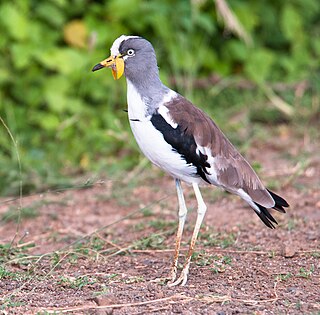
The white-crowned lapwing, white-headed lapwing, white-headed plover or white-crowned plover is a medium-sized wader. It is resident throughout tropical Africa, usually near large rivers.

Brachypelma is a genus of spiders in the family Theraphosidae (tarantulas). They may have bodies up to 6 cm long with legs of similar or greater lengths. Some species have brightly colored legs, with red or orange marks and rings.

Austracantha is a genus of spider with a single species, Austracantha minax, commonly known as the jewel spider or the Christmas spider. It is a member of the family Araneidae and is endemic to Australia. They are relatively small spiders, reaching a maximum total body length of only around 12 mm (0.47 in) for females, and 5 mm (0.20 in) for males. Their abdomen has six distinctive projections ("spines") that makes them easy to identify. They are predominantly a shiny black, with variable white, yellow, and orange patterns. Melanistic forms also occur during autumn. They are facultatively gregarious, and can be found in large aggregations of overlapping orb webs. They feed on small flying insects that get entangled in their webs. They are harmless to humans, though the webs can be a nuisance for bushwalkers. They are most abundant during the summer months.

The tiger snake is a large and highly venomous snake of southern Australia, including its coastal islands and Tasmania. These snakes are often observed and locally well known by their banding, black and yellow like a tiger, although the species can be highly variable in coloration and patterning. All populations are classified within the genus Notechis (Elapidae). Their diverse characteristics have been classified either as distinct species or by subspecies and regional variation.

The smooth toadlet is a species of Australian ground-dwelling frog native to the coast and west of the ranges of south-east Queensland, all of eastern New South Wales and north-eastern Victoria.

Bibasis harisa, the orange awlet, is a species of hesperid found in Asia. The butterfly was reassigned to genus Burara by Vane-Wright and de Jong (2003) and is considered by them to be Burara harisa.

Prostheclina pallida is a species of spider in the family Salticidae, native to Eastern Australia. It was described by Keyserling in 1882, and remained the only species in the genus until 2007, when six more species were described.
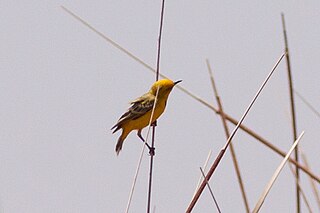
The yellow chat is a small passerine bird endemic to Australia. They are known for their remarkable adaptions that aid their survival in their arid habitat.

The grey-headed honeyeater is a species of bird in the family Meliphagidae. It is endemic to Australia.
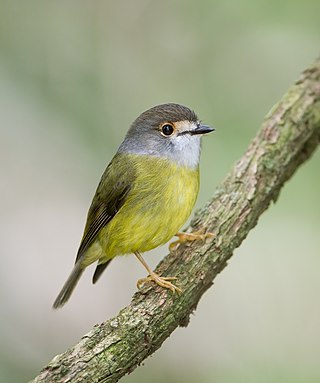
The pale-yellow robin is a species of passerine bird in the family Petroicidae. It is endemic to eastern Australia. Its natural habitat is subtropical or tropical moist lowland forests. It is a nondescript bird with grey head and olive upperparts, white throat and yellow underparts. The sexes are similar. Two subspecies are recognised: the smaller nana from North Queensland, and the larger and uncommon nominate race capito from southeast Queensland and northeastern New South Wales. It is insectivorous.
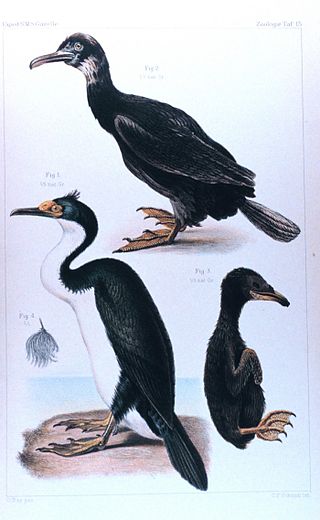
The Kerguelen shag is a species of cormorant endemic to the Kerguelen Islands in the southern Indian Ocean, one of the most isolated places on Earth. Many authorities consider it a subspecies of the imperial shag.

Amegilla is a large genus of bees in the tribe Anthophorini.

Amegilla bombiformis, commonly known as the teddy bear bee or golden haired mortar bee, is an Australian native bee in the family Apidae.
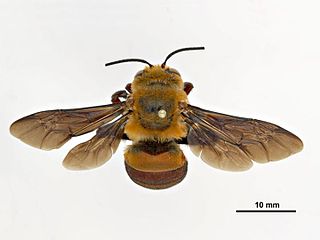
Amegilla dawsoni, sometimes called the Dawson's burrowing bee, is a species of bee that nests by the thousands in arid claypans in Western Australia. It is a long tongued bee, of the tribe Anthophorini and genus Amegilla, the second largest genus in Anthophorini.

Amegilla quadrifasciata, the white-banded digger bee, is a species of bee belonging to the family Apidae subfamily Apinae.
Fijocrypta is a monotypic genus of South Pacific brushed trapdoor spiders containing the single species, Fijocrypta vitilevu. Both genus and species were first described by Robert Raven in 1994, and they have only been found in Fiji. It was first found in rainforests in the eastern highlands of Viti Levu, the largest island in Fiji, from which the species name is derived. The genus name is derived from "Fiji" and the Latin word cryptus, meaning "hidden".
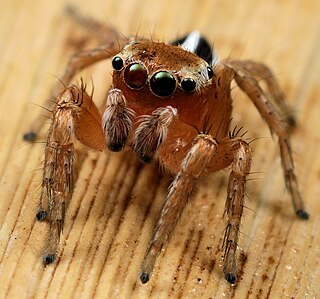
Evarcha acuta is a species of jumping spider in the genus Evarcha that lives in Namibia, Seychelles and South Africa. The species was first described in 2006 by Wanda Wesołowska. The spider is small, with a carapace measuring typically 1.6 mm (0.06 in) long and an abdomen between 1.4 and 1.9 mm long. The carapace is light brown with a short black eye field. The abdomen has patterns that vary depending on geography. The holotype, found near Brandberg Mountain in Namibia, has lines of brown patches on the top. Examples found in Free State, South Africa, have black lines on the top and sides. The spider can be most easily distinguished from other spiders in the genus by its copulatory organs. The male has a distinctive notch on a long straight projection from its tibia known as a tibial apophysis and a long embolus. The female has not been described.

Langelurillus manifestus is a species of jumping spider in the genus Langelurillus that lives in Tanzania. It was first described in 2000 by Wanda Wesołowska and Anthony Russell-Smith. The spider is small, with a carapace that is between 2.1 and 2.5 mm long and an abdomen between 2.0 and 2.2 mm long. The female carapace is lighter than the male and has a pattern of irregular patches, which may also be found in some examples of the female abdomen. The male abdomen is lighter and has a fawn streak down the middle. The legs are brown, the female having dark rings on its legs. It is similar to other related species, particularly Langelurillus rufus, but can be distinguished by the male's larger size and lighter coloration. The female has an oval epigyne that leads to seminal ducts that are shorter than Langelurillus rufus but longer than Langelurillus squamiger.

Brachyopa caesariata, the Plain-winged Sapeater, is an uncommon species of syrphid fly. It has been observed in Canada, Alaska and northern United States. Hoverflies get their names from the ability to remain nearly motionless while in flight. The adults are also known as flower flies for they are commonly found around and on flowers, from which they get both energy-giving nectar and protein-rich pollen. Larvae for this genus are of the rat-tailed type. B.caesariata larvae have not been described.




















